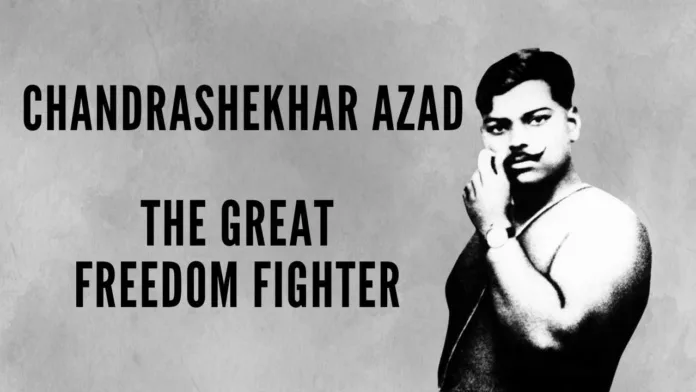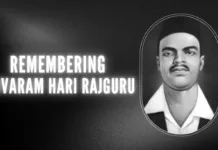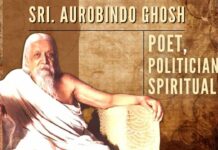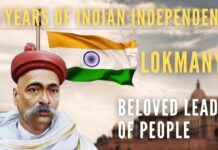
A valiant fighter! Remembering Shri. Chandrashekhar Azad’s legacy as a freedom fighter
Shri. Chandrashekhar ‘Azad’ was born as Chandrashekhar Tiwari on the 23rd of July 1906 in a small village called Bhavara, which is situated in the erstwhile princely state of Alirajpur, which is the current district of Jabhua in Madhya Pradesh to Sitaram Tiwari ji, a sincere and honest gardener and to Jagrani Devi, a good homemaker. His ancestors belonged to the Unnao region in present-day Uttar Pradesh. AZAD’s village in Madhya Pradesh was surrounded by the tribal villages inhabited by Bhils, who were forest people and great at archery/ hunting.
Chandrashekhar Azad was brave even as a child. Once, he suffered burns on his palm when he burnt a bonfire of crackers during the Deepawali festival but he didn’t even flinch. He did not even consider informing his mother about the accident as he did not deem it important enough. He was only eight years at that time.
Chandrashekhar studied in Bhavra’s government primary school. He had a strong physique and a powerful thinking mind. He was good at studies and he also liked playing a lot. His village, Bhavra was surrounded by forests. The Bhil tribals lived in the forest region. Chandrashekhar became friends with the Bhils. The Bhils, who were experts in archery bought honey and fruits for their friend, Chandrashekhar. Chandrashekar often accompanied his tribal friends on tiger-hunting expeditions into the depths of the forest. He became a good archer. He attained great focus and marksmanship.
One day, he had an argument with his father. Chandrashekhar felt that he had justice on his side whereas his father thought that justice was on his side in the argument. He was bold and always stood up against injustice of any kind. Chandrashekhar Tiwari was very upset at his father’s stubbornness and left his home. He was thirteen years old at the time. He walked for hours together covering a distance of forty miles on an empty stomach to reach the nearby railway station and he boarded a train. He got down at Bombay railway station and went on to work in jobs like washing utensils at a restaurant and in a construction company. He earned a couple of annas, every day. The lad who left his home at the age of thirteen never came back home, again. His life would take different turns and would be devoted to the service of our Motherland, Bharat.
In Bombay, Chandrashekhar lived an ordinary life, earning some money, saving some money, buying a few decent clothes and small things for himself, and watching Hindi movies in his spare time. He also had a fine physique and did a lot of physical exercises. He had a great personality and influenced everyone, who came in contact with him with his high ideals, sincerity, devotion to Bharat Mata, excellent character, and excellent looks. He had been able to earn his livelihood in Bombay but that did not leave Chandrashekhar, satisfied. He decided that it did not serve any higher purpose to remain in Bombay.
Chandrashekhar ‘Azad’ was born before Bharat’s independence. The freedom struggle was at a nascent stage when he was born. Chandrashekhar’s growing years were co-terminus with Bharat Mata’s more fervent attempts to attain her freedom from British hegemony. Bharat was the golden treasure of the British Empire. First, the British East India Company had drained Bharat and then the British Crown had taken over the administration and drained wealth from India to England.
Chandrashekhar went to Benaras or Kashi or present-day, Varanasi from Bombay. He decided to go there to become a scholar in Sanskrit as dreamt by his parents. Chandrashekhar Tiwari enrolled at Kashi Vidyapeeth and began his journey toward attaining a scholarship in the Sanskrit language.
Kashi was not just a great centre of learning but it was also a centre for the Indian struggle for Independence. Kashi Vidyapeeth became a breeding ground for Indian revolutionaries. Lal Bahadur Shastri and many other leaders of the Indian freedom struggle came from this educational centre.
Chandrashekhar Azad had the physical prowess of a bodybuilder/ boxer or wrestler. This was because he exercised regularly. However, he never used his great physical strength to trouble anyone. He used his great physical and mental prowess to protect the vulnerable people and for serving the just cause of freeing his motherland. He always fought against injustice. Once, he beat up a rowdy in Kashi, who used to torment women and who was a notorious eve-teaser. Chandrashekhar never beat anyone without a right reason. He was a man of great distinction and character. He was especially known for his benevolent and respectful treatment of women. He considered all women as his sisters and mothers.
At Kashi, Chandrashekhar became aware of the sufferings of his Bharatiya brethren under unjust British rule. He decided that his life’s mission was to free Bharat Mata. It was around that time that the Non-Cooperation movement (1920-21) began under Gandhi Ji.
Chandrashekhar Tiwari became very influenced by Gandhi Ji and the Non-Cooperation movement. The Non-Cooperation movement was essentially a method of the Bharatiya people not cooperating with the British in matters of education, law, and administration in order for the British aliens to realize that they were not wanted by the native Bharatiya people of Jambudweep or the Indian Sub-Continent to rule over them. Thus, the idea was to boycott courts, offices, schools, and colleges run by the Britishers and to organize various kinds of pressure tactics like demonstrations, meetings, protests, and public assemblies to show antagonism towards British rule and somehow make the unwanted foreign imperialist forces to leave Bharat and end years of subjugation and exploitation of the Bharatiya land, people, culture and languages by the Alien British Forces.
One day, as he walked along the banks of the river, Ganga, Chandrashekhar decided to join the freedom struggle. He soon left his studies, mid-way to contribute to the bigger cause of the nation.
The Non-Cooperation movement started in January 1921. The protesters opposed the sale of foreign goods. Chandrashekhar participated in the peaceful non-violent, non-cooperation movement in Kashi. He noticed a Police Officer beating an elderly protestor, who was carrying the Tri-Colour Flag in the procession. Chandrashekhar was both upset and angry at the mistreatment of the peaceful protestor. He threw a stone at the Police-Officer. The stone hit the policeman’s forehead. The policemen chased Chandrashekhar and finally caught him.
He was arrested and put on trial. He was produced in the Zilla magistrate Court of Khareghat in Kashi, the following day on the 20th of December 1921. The Judge was a very cruel man, who hated anyone rising against the unjust British regime. The Judge asked Chandrashekhar his name. The latter responded saying that his name was ‘AZAD’ (meaning, freedom in Hindi). The Judge asked his father’s name and young Chandrashekhar replied that his father’s name was ‘Freedom’. Chandrashekhar also told the baffled, stunned, angry, and unjust Judge that his home was Prison and his Profession was to free Bharat Mata. He gave defiant answers to the questions posed by the Judge and the angry Judge ordered that Chandrashekhar be punished with fifteen whips. So, Chandrashekhar was beaten for protesting peacefully. Every time, he was beaten, he would shout, ‘Vande Mataram’ and he shouted, ‘Mahatma Gandhi ji ki Jai’ in the eleventh round of beating. Sardar Gunda Singh, the Indian policeman who had caught AZAD is said to have been highly influenced by the magnetism of Chandrashekhar Ji. It is said that Gunda Singh took Chandrashekhar Ji to his home, gave him turmeric milk, and had the latter’s wounds attended to. From then on, he began to be called ‘AZAD’. AZAD means Freedom in the Hindi language. He started becoming more and more famous, day by day.
Meanwhile, in 1922, the Chauri-Chaura incident happened. The Incident took place on 4 February 1922 at a place called Chauri Chaura in what is today known as Gorakhpur district (erstwhile the United Provinces, British-ruled India) of Uttar Pradesh. The police fired upon a large group of protesters, who were participating in the Non-cooperation movement. The peaceful demonstrators turned violent because of Police brutality and set fire to a police station, which led to the death of three civilians and 22 policemen.
Mahatma Gandhi called off the Non-Cooperation Movement on the national level on 12 February 1922 owing to the violence of the incident. Gandhiji did not accept violence as a means to achieve independence for Bharat. In fact, he wrote many disparaging articles on the revolutionaries’ and their means to achieve independence for Bharat.
19 were sentenced to death and 14 to life imprisonment by the British in the Chauri-Chaura case. Naturally, Chandrashekhar Azad was disillusioned by Gandhiji’s radical step to end the Non-Cooperation Movement. He began to realize that getting beaten up or watching other freedom fighters get beaten up would not lead to independence for India. He began leaning towards a more revolutionary mindset.
Although Chandrashekhar Azad had the choice to join the Indian National Congress Party, he did not do so. It is to be recollected that the INC was founded by a Britisher A.O. Hume. Congress Party was never at war with the British. Rather, for a long time, they towed the line of the British regime. Since, its establishment in 1885 till 1915, for a period of almost 30 years, the INC was not serious about getting Independence for Bharat. Of course, all this changed after the entry of Gandhiji and S C Bose. Subhas’ outstanding brilliance and personality as well as Gandhiji’s Ahimsa were both powerful in influencing our Bharatiya Freedom Struggle in a positive way. Bal Gangadhar Tilak was another great leader of the independence movement.
The sad irony of the situation was that many people were more keen on what Gandhiji had to say than what Lal-Bal-Pal (Lala Lajpat Rai, Bal Gangadhar Tilak, and Bipin Chandra Pal) had to say.
Chandrashekhar realized that it was foolishness to allow oneself to be constantly beaten by evil British rulers. He slowly began having doubts about the possibility of attaining freedom for India through purely peaceful means as envisaged by Mohandas Gandhi.
Chandrashekhar Azad took a momentous and powerful decision not to join the Indian National Congress. He could have chosen the easy way out. He could have led a life of ease/ luxury and non-suffering/ non-imprisonment/ non-persecution by the British but he thought and did otherwise.
Varanasi was a great hub of revolutionaries fighting to free Bharat Mata. The Hindustan Republican Association (HRA) was formed by Jogesh Chandra Chatterjee, Ram Prasad Bismil, Sachindranath Sanyal, and Sachindranath Bakshi in 1924. Chandrashekhar Azad came in contact with HRA through Rajendra Lahiri, Pranavesh Chatterjee, and Manmathnath Gupta. He became an active member and learned to make bombs.
The revolutionaries were cruelly treated by the Britishers whereas members of the Indian National Congress were rather well treated by the British. This was because the Congress people did not really ‘fight’ against the British. The Policy of Ahimsa suited the British. The British administrators, rulers, institutions, and machinery felt safe with the ‘Protests’ of Congress. The British really became scared only after seeing the bravery of Bal Gangadhar Tilak, Veer Damodar Savarkar, Bhagat Singh, Chandrashekar Azad, Rash Behar Bose, Subhas Chandra Bose, S Rajguru, Sukhdev Thapar and other revolutionaries. It is thus, falsehood to think that Bharat became independent by purely adopting the principle of Ahimsa in its fight against the British.
We all know how finance, information, communication, and logistics are the lifelines of organizations. Money was needed to run The Hindustan Socialist Republication Association. Shri. Ram Prasad Bismil, leader and revolutionary of HSRA came up with the idea to loot a train carrying Rs.30,000 of government money. The money was the money of the Bharatiya people only, which had been collected illegitimately by an illegitimate imperialist regime.
This plan was carried out in what later became famous as the Kakori train Conspiracy Case. The revolutionaries, who took part in the famous Kakori Train Conspiracy, which took place on the 9th of August 1925 included Ram Prasad Bismil, Chandrashekhar Azad, Ashfaqullah Khan, Rajendra Lahiri, Keshab Chakravarthy, Sachindra Bakshi, Manmathnath Gupta, and others The ‘8 down’ train carrying the money was travelling from Hardoi to Lucknow (present-day Uttar Pradesh) on the 9th of August of 1925. One of the revolutionaries pulled the Emergency chain in the train as it approached Kakori. They overpowered the train guard and the heist was carried out. Ram Prasad Bismil and others were arrested. Some of those arrested were hung. Rajendra Lahiri, Ram Prasad Bismil, Ashfaq Ullah Khan, and Roshan Singh were hung for conspiring in the Kakori Conspiracy.
HRA completely broke down after the Kakori incident. Azad escaped and a bounty of Rs.2000 was put on AZAD’S head. There were lookout notices all over. Chandrashekhar Azad kept disguising himself to hide himself from the British-controlled Bharatiya Police. He dressed up as a sage, a labourer, and a chauffeur among others. He kept moving to different places like Jhansi, Lucknow, Delhi, Lahore, and Varanasi amongst others. In Jhansi, he was protected by Master Rudra Narayan Singh. He disguised as a Sadhu – ‘Hari Shankar Brahmachari’. He built a hut near the Hanuman Mandir, there along the banks of the river, Satar. He used to teach young children and revolutionaries in Jhansi. He made some good friends in Jhansi like Sadashivrao Malkapurkar, Vishwanath Vaishampayan, and Bhagawan Das Mahaur. He was also close to Pandit Raghunath Vinayak Dhulekar and Pandit Sitaram Bhaskar Bhagwat. He then went to Orchha to escape from the Police. Chandrashekar Azad used to give the book, ‘The Indian War of Independence 1857’ written by Veer Vinayak Damodar Savarkar to the revolutionaries to read. The book was mandatory reading material for the Bharatiya revolutionaries. Azad taught the revolutionaries to make bombs.
Chandrashekhar Azad also loved playing games with the Police. He would provoke them and intimidate them often. The policemen were often scared of Azad. Chandrashekhar Azad promised himself that he would never be captured alive by them. In fact, during his period ‘in hiding’ and in disguise, he was able to acquire a Driver’s Licence issued by the Police Superintendent, himself. He was a person of great skills and intelligence. The Police Officer could not guess that he was interacting with the freedom fighter, AZAD. In fact, the Superintendent of Police liked the driving skills of AZAD and would often call AZAD to drive his car! AZAD’s skills, bravery, personality, and intelligence were simply astounding!
There are also various recorded instances of Chandrashekhar Azad coming to the rescue of the weak and vulnerable.
Later, AZAD met Bhagat Singh. Bhagat Singh was from Punjab and he was the founder of the Revolutionary group, Navjeevan Sabha at Lahore. Punjab had been through the gruesome Jallianwala Bagh massacre in 1919. Earlier, the unjust Rowlatt Act had been passed by the Imperial Legislative Council in 1919 granted great powers to the government to repress political activities and allowed for the detention of political prisoners without trial for two years. In March 1919, the Khilafat Committee had been formed. In December 1920, the Indian National Congress adopted the Non-Cooperation Movement.
The two revolutionaries, Chandrashekhar Azad and Bhagat Singh met at Delhi and soon formed a strong bond of friendship. They along with Sheo Varma, Mahaveer Singh, and Bhagawati Charan Vohra among others decided to give a new form and name to the Hindustan Republican Army in 1928. They called it Hindustan Socialist Republican Association. Chandrashekhar Azad was not present at the first meeting but he was unanimously chosen as the Commander-in-Chief of the HSRA.
Meanwhile, the Simon Commission arrived in 1927. It was meant to deliver reforms but mainly consisted only of British representation. A lot of protests took place against the Simon Commission asking the Simon Commission to return. Lala Lajpat Rai led people in Lahore to protest against the Simon Commission. He was lathi-charged on the orders of Colonel Scott. Lala Ji suffered from multiple injuries. He died after a week on the 17th of November, 1928.
Bhagat Singh and Chandrasekhar were very angry against Colonel Scott for issuing the orders to lathi-charge the protestors. They wanted to kill Scott to avenge the death of Lalaji. Exactly, a month after the demise of Lala Lajpat Rai, the revolutionaries assembled near the office of the Superintendent of Police at Lahore. They were fully armed and wanted to reply to bullets with bullets.
They ended up murdering Police Officer, Saunders, who was the one responsible for killing Lalaji on 17th Dec 1929. Bhagat Singh and Raj Guru had fired at Saunders. The Policeman by name, Charan Singh was about to catch Bhagat Singh. AZAD shot Charan Singh. Bhagat and Rajguru were able to escape for the time being.
The Police began searching for the revolutionaries. AZAD left Lahore disguised as a seer. Bhagat Singh disguised himself as a government officer at the suggestion of AZAD. Rajguru dressed his servant. Revolutionary Durgadevi dressed up as a government officer’s wife and they were able to escape Lahore.
Durgadevi was the wife of revolutionary, Bhagawati Charan who died while examining a bomb. AZAD shed many tears upon the death of Bhagawati Charan, especially taking care of his child, who was weeping inconsolably upon the loss of his father. Durgadevi went into a period of extreme grief.
The year was 1929. Lord Irwin was the Viceroy of India. Lord Irwin introduced two bills in 1929. The first was the Public Safety Bill and the second was the Trade Disputes Bill. The Bharatiya people were not happy with the high-handedness of the British rulers.
Chandrashekhar Azad came up with the plan to bomb the Central Assembly in Delhi and also to throw hand-outs. Bhagat Singh, the fiery revolutionary from Punjab was the person to bomb the Central Assembly. Bhagat Singh along with Batukeshwar Dutt threw a bomb at the Central Assembly on the 8th of April 1929. The Revolutionaries wanted to make the deaf British rulers hear the painful wailings of the suffering Bharatiya people under the cruel, exploitative, unjust, foreign, and imperialist British rulers.
In October 1929, Lord Irwin made a vague offer of a ‘Dominion Status’ for India. However, our Bharatiya Freedom Fighters were not satisfied. The Congress demanded ‘Purna Swaraj’ or Complete Independence in December 1929. Chandrashekhar Azad was also indirectly involved in the attempt to blow up the Viceroy’s train in December 1929.
Gandhi ji started the Civil Disobedience Movement on the 6th of April, 1930 after he reached Dandi in Gujarat and had made Salt. The Civil Disobedience Movement was called off after the Gandhi-Irwin Pact.
Thus, the first major action of the HSRA was the murder of J P Saunders to avenge the death of Lala Lajpat Rai and the second was the bombing of the Central Assembly by Bhagat Singh and Batukeshwar Dutta to protest against the Public Safety Bill and the Trade Disputes Bill.
AZAD visited Sitapur Jail to meet Ganesh Shankar Vidyarthi. Vidyarthi ji had helped the revolutionaries handle the Kakori Conspiracy Case. So, AZAD ji felt that he would do the same in the Central Assembly Bombing case and John Saunders assassination case. Vidyarthiji suggested that Chandrashekhar should meet Chacha Nehruji in this regard.
On the 27th of February 1931, Chandrashekhar Azad met Shri. Jawaharlal Nehru at Prayagraj requested help to free Bhagat Singh and others, who were due to be executed on the 23rd of March 1931. Later, he went to Alfred Park to meet a person. Both of them sat talking under a tree inside Alfred Park.
AZAD died the very same day at Alfred Park (now, Chandrashekar Azad Park) after fighting against a large battalion of British forces (more than 80 in number), who had got information about the whereabouts of AZAD through a spy. Shri. Chandrashekar Azad shot himself with the last remaining bullet in his pistol in Alfred Park after killing many policemen. He remained AZAD or FREE till the end. A man who could have enjoyed the pleasures of youth and lived in ease – chose instead to serve our nation, sacrificing his personal life and professional ambitions. He died in the service of Bharat Mata.
Chandrashekar Azad had been led down by some dastards, cowards, jealous folk, and betrayers, who had informed the British about Chandrashekhar’s whereabouts. It appears that the British Police had bought a man within HSRA. They made him, their spy. The spy had informed the Police about the activities and movements of AZAD. Yet another betrayer in Bharatiya history. Time and again, there have been betrayers for whom money is above nation and honour. It is important to remember the betrayers of Bharat like Shiladitya and Mir Jaffer.
The betrayers are the same group, who have looted Bharat over the years. They appear to be the same gang, that led down Dr. Shyama Prasad Mukherjee, Pandit Deen Dayal Upadhyaya ji, Netaji Subhas’ Chandra Bose, and our Martyrs, Bhagat Singh, Sukhdeo Thapar, S Rajguru among others. Chandrashekhar Azad was yet another Lion to bite the dust because of the betrayers. Chandrashekhar Azad’s nephew, Sujit Azad alleged that it was Jawaharlal Nehru, who provided specific information regarding his whereabouts in Prayagraj to the British administration. It is alleged by Sujit Azad that no one other than Jawaharlal Nehru and members of HSRA knew about the whereabouts of Azad. Sujit Azad wanted a Commission to investigate the death of his uncle.
After leaving Bhavara, it is said that AZAD visited his old, poor, and ailing parents only once. An attempt was made by the well-wishers of AZAD to collect some funds for his parents but AZAD told them that the money collected using his name belonged to the nation and were not meant for his family. AZAD standards of straightforwardness were sky-high. People serving the nation should learn from his life about public propriety and honesty.
Bhagat Singh along with S Rajguru and Sukhdeo Thapar who had been arrested in the case of the bombing of the Central Assembly in Delhi and in the Lahore murder case of Saunders were hanged on the 23rd of March 1931 in what later became known as Martyrs Day. Gandhiji, Chacha Nehruji, and other Congresswadis did almost nothing to stop the hanging of the great revolutionaries.
Thus, Shri. Chandrashekhar Azad was one of Bharat’s finest and bravest freedom fighters. He is one of those revolutionary fighters, whom we recollect alongside the famous and awe-inspiring freedom fighters- Bhagat Singh, S Rajguru, Sukhdeo Thapar, Ramprasad Bismil, Ashfaq Ullah Khan, and others.
Jai Hind!
Note:
1. Text in Blue points to additional data on the topic.
2. The views expressed here are those of the author and do not necessarily represent or reflect the views of PGurus.
PGurus is now on Telegram. Click here to join our channel and stay updated with all the latest news and views
For all the latest updates, download PGurus App.
- Shaheed Diwas: Remembering Bhagat Singh, Rajguru, Sukhdev on Martyr’s Day - March 23, 2024
- Chhatrapati Shivaji Maharaj – The unparalleled visionary leader - February 19, 2024
- The Constitution Day of Bharat - November 26, 2023










